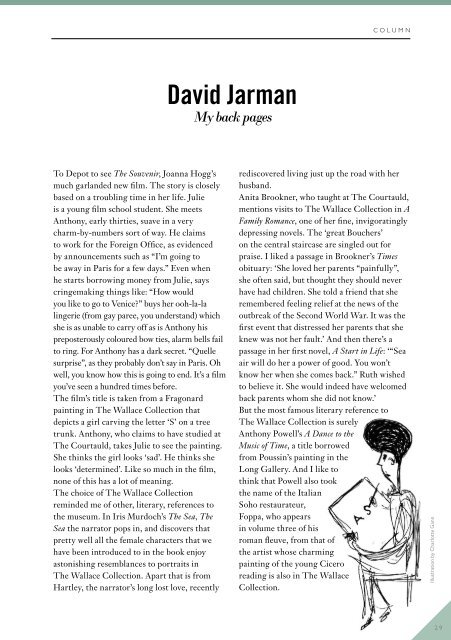Viva Lewes Issue #157 October 2019
You also want an ePaper? Increase the reach of your titles
YUMPU automatically turns print PDFs into web optimized ePapers that Google loves.
COLUMN<br />
David Jarman<br />
My back pages<br />
To Depot to see The Souvenir, Joanna Hogg’s<br />
much garlanded new film. The story is closely<br />
based on a troubling time in her life. Julie<br />
is a young film school student. She meets<br />
Anthony, early thirties, suave in a very<br />
charm-by-numbers sort of way. He claims<br />
to work for the Foreign Office, as evidenced<br />
by announcements such as “I’m going to<br />
be away in Paris for a few days.” Even when<br />
he starts borrowing money from Julie, says<br />
cringemaking things like: “How would<br />
you like to go to Venice?” buys her ooh-la-la<br />
lingerie (from gay paree, you understand) which<br />
she is as unable to carry off as is Anthony his<br />
preposterously coloured bow ties, alarm bells fail<br />
to ring. For Anthony has a dark secret. “Quelle<br />
surprise”, as they probably don’t say in Paris. Oh<br />
well, you know how this is going to end. It’s a film<br />
you’ve seen a hundred times before.<br />
The film’s title is taken from a Fragonard<br />
painting in The Wallace Collection that<br />
depicts a girl carving the letter ‘S’ on a tree<br />
trunk. Anthony, who claims to have studied at<br />
The Courtauld, takes Julie to see the painting.<br />
She thinks the girl looks ‘sad’. He thinks she<br />
looks ‘determined’. Like so much in the film,<br />
none of this has a lot of meaning.<br />
The choice of The Wallace Collection<br />
reminded me of other, literary, references to<br />
the museum. In Iris Murdoch’s The Sea, The<br />
Sea the narrator pops in, and discovers that<br />
pretty well all the female characters that we<br />
have been introduced to in the book enjoy<br />
astonishing resemblances to portraits in<br />
The Wallace Collection. Apart that is from<br />
Hartley, the narrator’s long lost love, recently<br />
rediscovered living just up the road with her<br />
husband.<br />
Anita Brookner, who taught at The Courtauld,<br />
mentions visits to The Wallace Collection in A<br />
Family Romance, one of her fine, invigoratingly<br />
depressing novels. The ‘great Bouchers’<br />
on the central staircase are singled out for<br />
praise. I liked a passage in Brookner’s Times<br />
obituary: ‘She loved her parents “painfully”,<br />
she often said, but thought they should never<br />
have had children. She told a friend that she<br />
remembered feeling relief at the news of the<br />
outbreak of the Second World War. It was the<br />
first event that distressed her parents that she<br />
knew was not her fault.’ And then there’s a<br />
passage in her first novel, A Start in Life: ‘“Sea<br />
air will do her a power of good. You won’t<br />
know her when she comes back.” Ruth wished<br />
to believe it. She would indeed have welcomed<br />
back parents whom she did not know.’<br />
But the most famous literary reference to<br />
The Wallace Collection is surely<br />
Anthony Powell’s A Dance to the<br />
Music of Time, a title borrowed<br />
from Poussin’s painting in the<br />
Long Gallery. And I like to<br />
think that Powell also took<br />
the name of the Italian<br />
Soho restaurateur,<br />
Foppa, who appears<br />
in volume three of his<br />
roman fleuve, from that of<br />
the artist whose charming<br />
painting of the young Cicero<br />
reading is also in The Wallace<br />
Collection.<br />
Illustration by Charlotte Gann<br />
29

















